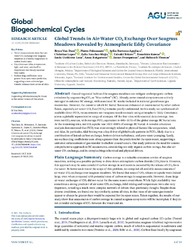Global Trends in Air‐Water CO2 Exchange Over Seagrass Meadows Revealed by Atmospheric Eddy Covariance
Barreras‐Apodaca, Aylin
Sanchez‐Mejia, Zulia
Tokoro, Tatsuki
Loza, Lucia Gutiérrez
Fourqurean, James
Thomas, Helmuth
Van Dam, Bryce; Polsenaere, Pierre; Barreras‐Apodaca, Aylin; Lopes, Christian; Sanchez‐Mejia, Zulia; Tokoro, Tatsuki; Kuwae, Tomohiro; Loza, Lucia Gutiérrez; Rutgersson, Anna; Fourqurean, James; Thomas, Helmuth, 2021: Global Trends in Air‐Water CO2 Exchange Over Seagrass Meadows Revealed by Atmospheric Eddy Covariance. In: Global Biogeochemical Cycles, Band 35, 4, DOI: 10.23689/fidgeo-4337.
 |
Dokument öffnen: |
Coastal vegetated habitats like seagrass meadows can mitigate anthropogenic carbon emissions by sequestering CO2 as “blue carbon” (BC). Already, some coastal ecosystems are actively managed to enhance BC storage, with associated BC stocks included in national greenhouse gas inventories. However, the extent to which BC burial fluxes are enhanced or counteracted by other carbon fluxes, especially air‐water CO2 flux (FCO2) remains poorly understood. In this study, we synthesized all available direct FCO2 measurements over seagrass meadows made using atmospheric Eddy Covariance, across a globally representative range of ecotypes. Of the four sites with seasonal data coverage, two were net CO2 sources, with average FCO2 equivalent to 44%–115% of the global average BC burial rate. At the remaining sites, net CO2 uptake was 101%–888% of average BC burial. A wavelet coherence analysis demonstrated that FCO2 was most strongly related to physical factors like temperature, wind, and tides. In particular, tidal forcing was a key driver of global‐scale patterns in FCO2, likely due to a combination of lateral carbon exchange, bottom‐driven turbulence, and pore‐water pumping. Lastly, sea‐surface drag coefficients were always greater than the prediction for the open ocean, supporting a universal enhancement of gas‐transfer in shallow coastal waters. Our study points to the need for a more comprehensive approach to BC assessments, considering not only organic carbon storage, but also air‐water CO2 exchange, and its complex biogeochemical and physical drivers. Plain Language Summary:
Carbon storage is a valuable ecosystem service of seagrass meadows, serving as a possible pathway to draw down atmospheric carbon dioxide (CO2) levels. However, this approach may be unsuccessful if carbon storage in sediments is exceeded by the release of CO2 from the water. To better understand the scope of this problem, we compiled all available measurements of air‐water CO2 exchange over seagrass meadows. We found that rates of CO2 release or uptake were indeed large, even when compared with potential rates of carbon storage in seagrass soils. However, these large air‐water exchanges of CO2 did not occur for the same reason everywhere. While light availability was sometimes a strong predictor of air‐water CO2 exchange, tidal mixing and temperature were also very important, revealing a much more complex network of drivers than previously thought. Despite these diverse conditions, we found one key similarity across all sites, in that rates of air‐water gas transfer appear to always be greater than would be expected for the open ocean. Taken together, the results of our study show that assessments of carbon storage in coastal seagrass ecosystems will be incomplete if they do not consider exchanges of CO2 between the water and air. Key Points:
Direct measurements show that air‐water CO2 exchange over seagrass meadows is of similar magnitude to carbon burial rates.
Key drivers are tides, temperature, light, and wind, which off in importance over hourly seasonal time scales.
Surface drag coefficients were greater than open water prediction, suggesting a near‐universal gas transfer enhancement across all sites.
Statistik:
ZugriffsstatistikSammlung:
This is an open access article under the terms of the Creative Commons Attribution License, which permits use, distribution and reproduction in any medium, provided the original work is properly cited.

